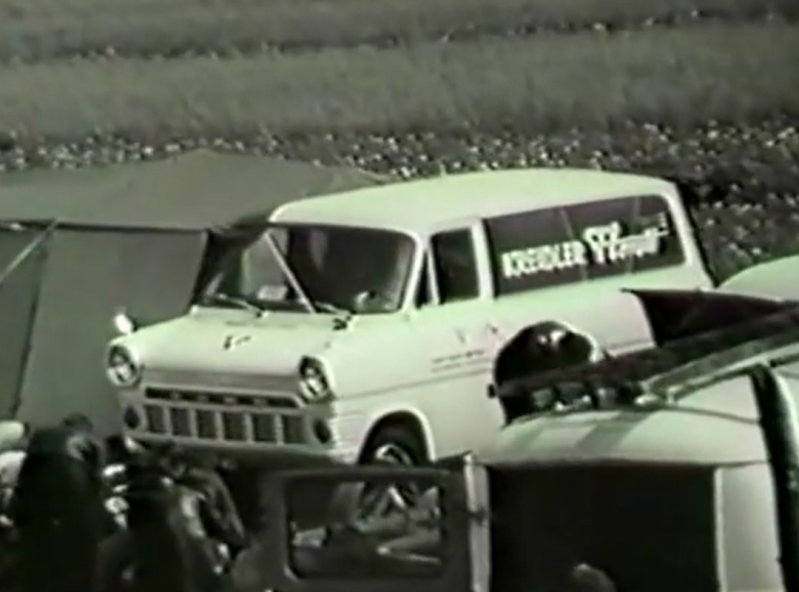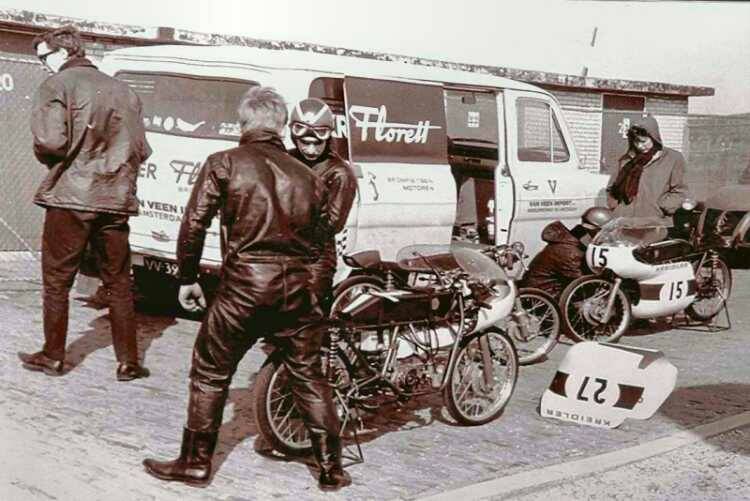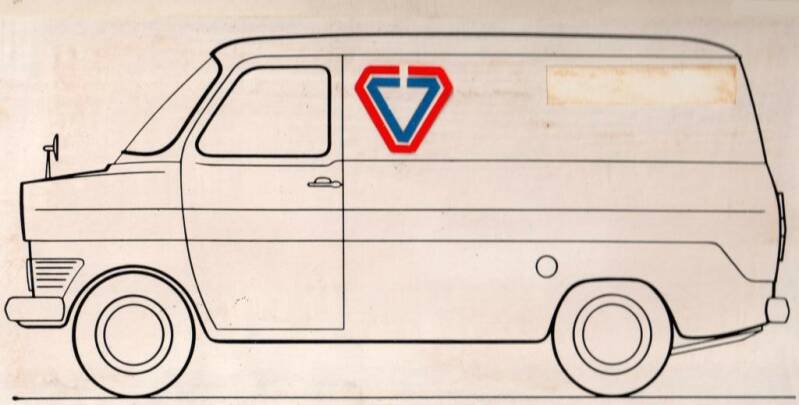Ford Transit Mk1 Van (SWB)
- Manufacturer: Ford Europe
- Years: 1965 - 1977
- Plants: Genk, Belgium
Langley, Slough, England, UK
Southampton, UK (1972–1978)
Amsterdam, Netherlands
- Predecessor: Ford FK1000/1250
- Successor: Transit Mk2
- Body style: Minibus, Van, Flatbed truck
- Engine: Petrol: 1.3/1.5/1.7 L Taunus V4
1.7/2.0 L Essex V4
3.0 L Essex V6
3.3 L I6 (Australia from 1973)
Diesel: 1.8 L Perkins I4
2.5 L York I4
- Transmission: 3/4-speed manual unsynchronized
- Length: 4192 mm
- Height: 1931 mm
- Wheelbase: 2692 mm
Gallery:
Transit History
The Ford Transit, also known as the Ford T-Series in some markets, is a range of light commercial vehicles produced by Ford since 1965. Sold primarily as a cargo van, the Transit is also built as a passenger van (marketed as the Ford Tourneo since 1995), minibus, cutaway van chassis, and as a pickup truck. Over 8,000,000 Transit vans have been sold, making it the third best-selling van of all time and have been produced across four basic platform generations (debuting in 1965, 1986, 2000, and 2013 respectively), with various "facelift" versions of each.
The first product of the merged Ford od Europe, the Transit was marketed through Western Europe and Australia; by the end of the twentieth century, it was marketed nearly globally with the exception of North America until 2013 when it replaced the Ford E-Series in 2015. The Transit has been the best-selling light commercial vehicle in Europe for forty years, and in some countries the term "Transit" has passed into common usage as a generic trademark applying to any light commercial van in the Transit's size bracket.
While initially designed for the European market, the Ford Transit is now produced in Asia, North America, and Europe for worldwide buyers. Upon production in North America, the Transit won second place in Motor Trend's 2015 'Truck of the Year' award, behind the newly introduced mid-size Chevrolet Colorado pickup and ahead of the new Ford F-150. As of 2016, the Transit was the best-selling van of any type in the United States, minivan sales included. The Transit is an important part of Ford's 57 percent share of the full-size van market in the USA.
The Mk1
The first generation Transit, or the Transit Mark I in the United Kingdom, was introduced in October 1965, taking over directly from the Thames 400E. This generation had the longest production run of any Transit to date, staying largely unaltered for 12 years until the major facelift of 1978, with overall production lasting for over 20 years before finally being replaced by the all-new VE6 platform in 1986.
The van was produced initially at Ford's Langley facility in Berkshire, England (a former Second World War aircraft factory which had produced Hawker Hurricane fighters), but demand outstripped the capability of the plant, and production was moved to Southampton until closure in 2013 in favour of the factory at İzmit, Turkey.
Transits were also produced in Ford's Genk factory in Belgium and also Turkey. Transits were produced in Amsterdam for the local market from the mid-1970s until the end of 1981. This factory had ample capacity, since the Ford Transcontinental produced there had little success (total production 8000 in 6 years). Although the Transit sold well in the Netherlands, it was not enough to save the factory, which closed in December 1981.
The Transit was introduced to replace the Ford Thames 400E, a small mid-engined forward control van noted for its narrow track which was in competition with similar-looking but larger vehicles from the BMC J4 and J2 vans and Rootes Group's Commer PB ranges. In a UK market segment then dominated by the Bedford CA, Ford's Thames competitor, because of its restricted load area, failed to attract fleet users in sufficient numbers. Ford switched to a front-engined configuration, as did the 1950s by Bedford with their well-regarded CA series vans. Henry Ford II's revolutionary step was to combine the engineering efforts of Ford Of Britain and Ford of Germany to create a prototype for the Ford of Europe of today—previously the two subsidiaries had avoided competing in one another's domestic markets but had been direct competitors in other European markets.
The Transit was a departure from the European commercial vehicles of the day with its American-inspired styling—its broad track gave it a huge advantage in carrying capacity over comparable vehicles of the day. Most of the Transit's mechanical components were adapted from Ford's car range of the time. Another key to the Transit's success was the sheer number of different body styles: panel vans in long and short wheelbase forms, pick-up truck, minibuses, crew-cabs to name but a few.
The engines used in the UK were the Essex V4 for the petrol-engined version in 1.7 L and 2.0 L capacities. By using relatively short V-4 engines Ford were able to minimise the additional length necessitated to place the engine ahead of the driver. Another popular development under the bonnet was the equipping of the van with an alternator at time when the UK market competitors expected buyers to be content with a dynamo. A 43 bhp (32 kW) diesel engine sourced from Perkins was also offered. As this engine was too long to fit under the Transit's stubby nose, the diesel version featured a longer bonnet - which became nicknamed as the "pig snout". The underpowered Perkins proved unpopular, and was replaced by Ford's own York unit in 1972. For mainland Europe the Transit had the German Ford Taunus V4 engine in Cologne 1.3, 1.5, and 1.7- or Essex 2.0-litre versions. The diesel version's long nose front was also used to accommodate the Ford 3.0 L Ford Essex V6 engine (UK) for high performance applications such as vans supplied to police and ambulance services. In Australia, in 1973, to supplement the two Essex V4 engines that were available the Transit was released with the long-nose diesel front used to accommodate an inline 6-cylinder engine derived from the Ford Falcon.
The Metropolitan Police reported on this vehicle in 1972 via a Scotland Yard spokesman that 'Ford Transits are used in 95 per cent of bank raids. With the performance of a car, and space for 1.75 tonnes of loot, the Transit is proving to be the perfect getaway vehicle...', describing it as 'Britain's most wanted van'.
The adoption of a front beam axle in place of a system incorporating independent front suspension that had featured on its UK predecessor might have been seen as a backward step by some, but on the road commentators felt that the Transit's wider track and longer wheelbase more than compensated for the apparent step backwards represented by Ford's suspension choices. Drivers appreciated the elimination of the excessive noise, smell and cabin heat that resulted from placing the driver above or adjacent to the engine compartment in the Thames 400E and other forward control light vans of the 1950s and early 1960s.
The Transit was also assembled in South Africa between 1967 and 1974, the last Transit to be sold in that country until 2013, when a fully imported model was introduced
Referenced website: https://en.wikipedia.org/wiki/Ford_Transit
Kreidler Van Veen Transit
Below you see the original designs for the Transit Servicebus that Van Veen had in mind. These plans were found in the original Kreidler-files (now owned by John Bos, from Ersatzteildienst für Original Kreidler Fahrzeuge Portugal).












Create Your Own Website With JouwWeb